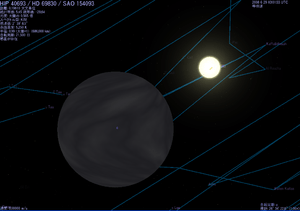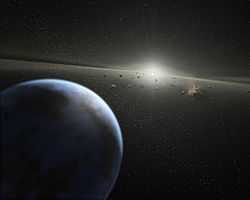HD 69830 c
| Extrasolar planet | List of extrasolar planets | |
|---|---|---|
 (Celestia image) | ||
| Parent star | ||
| Star | HD 69830 | |
| Constellation | Puppis | |
| Right ascension | (α) | 08h 18m 23.947s[1] |
| Declination | (δ) | −12° 37′ 55.81″[1] |
| Apparent magnitude | (mV) | 5.95 |
| Distance | 40.7 ± 0.2[1] ly (12.49 ± 0.05[1] pc) | |
| Spectral type | K0V | |
| Mass | (m) | 0.86 ± 0.03 M☉ |
| Radius | (r) | 0.89 R☉ |
| Temperature | (T) | 5385 ± 20 K |
| Metallicity | [Fe/H] | −0.05 ± 0.02 |
| Age | 5.1–6.1 Gyr | |
| Orbital elements | ||
| Semimajor axis | (a) | 0.186 AU |
| Eccentricity | (e) | 0.13 ± 0.06 |
| Orbital period | (P) | 31.56 ± 0.04 d |
| Argument of periastron |
(ω) | 221 ± 35° |
| Time of periastron | (T0) | 2,453,469.6 ± 2.8 JD |
| Semi-amplitude | (K) | 2.66 ± 0.16 m/s |
| Physical characteristics | ||
| Minimum mass | (m sin i) | 0.038 MJ |
| Temperature | (T) | ~522 |
| Discovery information | ||
| Discovery date | May 18, 2006 | |
| Discoverer(s) | Lovis et al.[2] | |
| Discovery method | Radial velocity | |
| Discovery status | Published[2] | |
| Database references | ||
| Extrasolar Planets Encyclopaedia | data | |
| SIMBAD | data | |
| Exoplanet Archive | data | |
| Open Exoplanet Catalogue | data | |
HD 69830 c is an exoplanet orbiting HD 69830. It is the second-closest planet in its system and likely to be a rocky planet, not a gas giant.[2] If it had formed as a gas giant, it would have stayed that way.[3]
References
- ↑ 1.0 1.1 1.2 1.3 van Leeuwen, F. (2007). "Validation of the new Hipparcos reduction". Astronomy and Astrophysics 474 (2): 653–664. arXiv:0708.1752. Bibcode:2007A&A...474..653V. doi:10.1051/0004-6361:20078357.Vizier catalog entry
- ↑ 2.0 2.1 2.2 Lovis, Christophe et al. (2006). "An extrasolar planetary system with three Neptune-mass planets" (PDF). Nature 441 (7091): 305–309. arXiv:astro-ph/0703024. Bibcode:2006Natur.441..305L. doi:10.1038/nature04828. PMID 16710412.
- ↑ H. Lammer et al. (2007). "The impact of nonthermal loss processes on planet masses from Neptunes to Jupiters" (PDF). Geophysical Research Abstracts 9 (7850).
Coordinates: ![]() 08h 18m 23.9s, −12° 37′ 55.8″
08h 18m 23.9s, −12° 37′ 55.8″
| ||||||||||||||||
| ||||||||||||||||||||||||||||||||||||||||||||||||||||||||||||||||||||||
